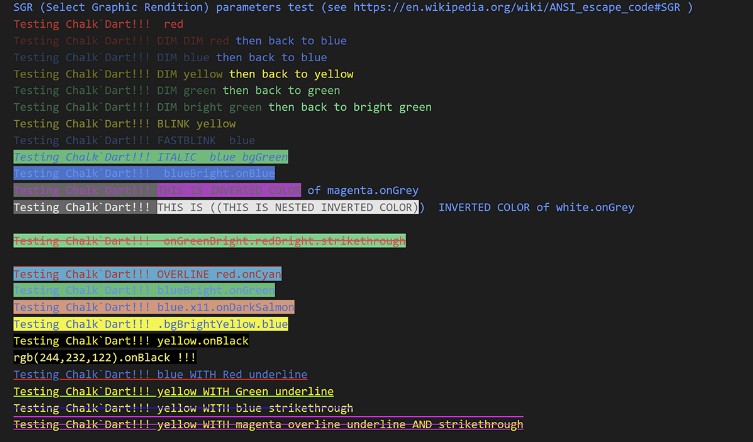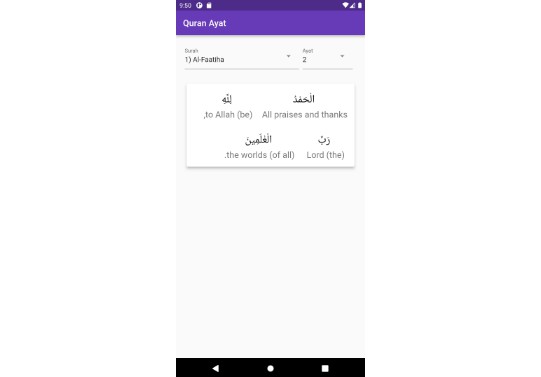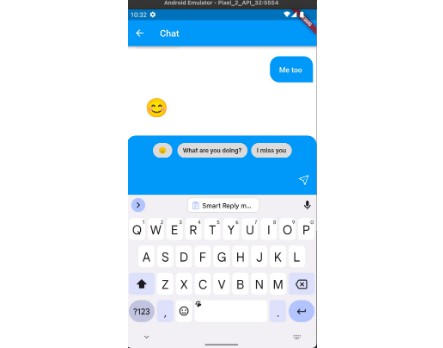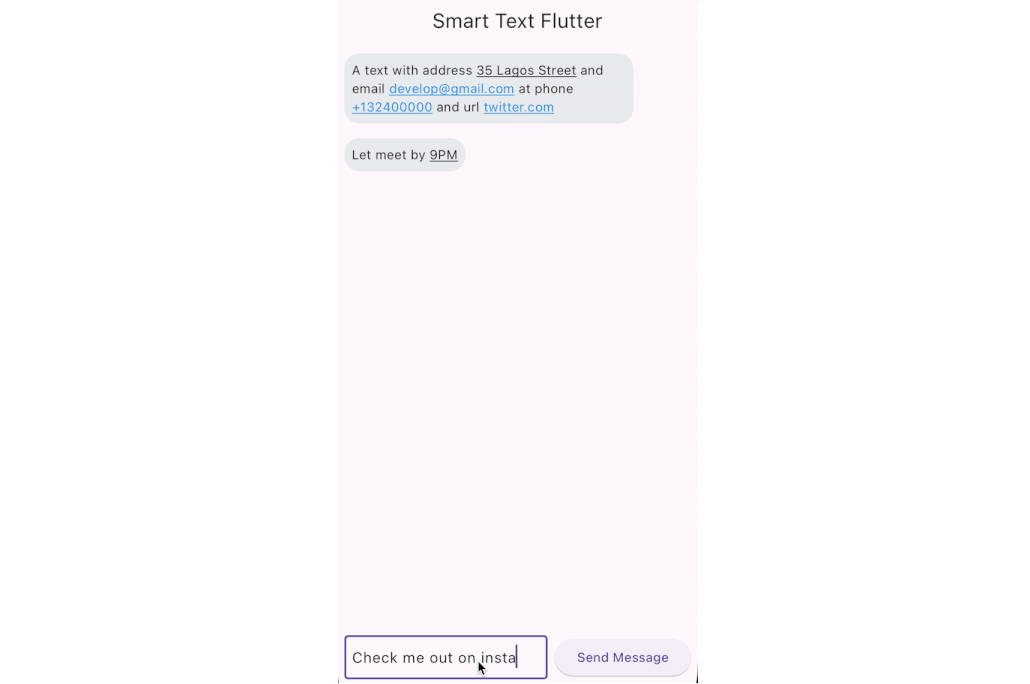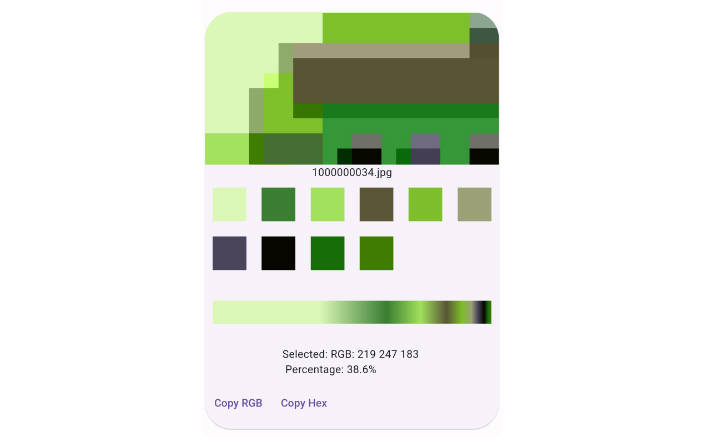vscode debug console
windows terminal
Console/Terminal text coloring and styling library for Dart
‘Terminal string styling done right’
I created this for my Dart/Flutter development logging almost 2 years ago now, and I have finally taken the time to clean it up and get it released as a package. In the mean time I added full ANSI support to the Visual Studio Code debugging console as well as just finishing full ANSI support for the Dart-Pad console as well. You can use this within your VSCode debugger to enable colorful, styled logging today. ?
Check out example/chalkdart_example.dart for some cool examples of what it is capable of.
If you have used the Chalk.js package within the npm/node.js environment you know how nice and easy it makes text coloring and styling! This ChalkDart version can be used essentially exactly as the js version.
Full Api Dart Docs can be found here
Features and bugs
Please file feature requests and bugs at the issue tracker.
Highlights
- Expressive API
- Highly performant
- Ability to nest styles
- Supports dynamic argument list and automatically handles printing Maps, Lists, Iterables and Function closures
- 256/Truecolor color support
- All standard X11/CSS/SVG colors can be accessed for by name.
- Ignores Auto-detected ANSI color support/as common Dart/Flutter IDE’s report this incorrectly.
- Not an extentension of the
Stringclass. - Clean and focused
- Actively maintained
Install
$ dart pub add chalkdart
Usage
import 'package:chalkdart/chalk.dart';
print(chalk.yellow.onBlue('Hello world!'));
Chalk comes with an easy to use composable API where you just chain and nest the styles you want.
import 'package:chalkdart/chalk.dart';
// Combine styled and normal strings
print(chalk.blue('Hello') + ' World' + chalk.red('!'));
// Compose multiple styles using the chainable API
print(chalk.blue.onRed.bold('Hello world!'));
// Pass in multiple arguments
print(chalk.blue('Hello', 'World!', 'Foo', 'bar', 'biz', 'baz'));
// Nest styles
print(chalk.red('Hello', chalk.underline.bgBlue('world') + '!'));
// Nest styles of the same type even (color, underline, background)
print(chalk.green(
'I am a green line ' +
chalk.blue.underline.bold('with a blue substring') +
' that becomes green again!'
));
// use in multiline string with interpolation
print('''
CPU: ${chalk.red('90%')}
RAM: ${chalk.green('40%')}
DISK: ${chalk.yellow('70%')}
''');
// or with inline calcs
print('''
CPU: ${chalk.red(cpu.totalPercent)}%
RAM: ${chalk.green((ram.used / ram.total * 100))}%
DISK: ${chalk.rgb(255,131,0)((disk.used / disk.total * 100))}%
''');
// Use RGB colors in debug console or terminals that support it.
print(chalk.keyword('orange')('Yay for orange colored text!'));
print(chalk.rgb(123, 45, 67).underline('Underlined reddish color'));
print(chalk.hex('#DEADED').bold('Bold gray!'));
Easily define your own themes:
import 'package:chalkdart/chalk.dart';
const error = chalk.bold.red;
const warning = chalk.keyword('orange');
print(error('Error!'));
print(warning('Warning!'));
const name = 'Tim Maffett';
print(chalk.green('Hello $name'));
//=> ‘Hello Tim Maffett’
API
chalk.<style>[.<style>...](string, [string...])
Example: chalk.red.bold.underline('Hello', 'world');
Chain styles and call the last one as a method with a string argument. Order doesn’t matter, and later styles take precedent in case of a conflict. This simply means that chalk.red.yellow.green is equivalent to chalk.green.
String interpolation can be ised or multiple arguments can be listed and will be separated by space (or the string specified by joinWith). The arguments can be of any type, Map<>, List<>, Iterable and Functions/Function closures are also supported. By default Lists are joined together with a ‘ ‘(space), but the joinWith method can be used to specify a different join string. Up to 15 arguments can be included as arguments to a Chalk object.
Styles
Modifiers
reset– Resets the current color chain.blink– Make text blink.rapidblink– Make text blink rapidly.bold– Make text bold.dim– Emitting only a small amount of light.italic– Make text italic.underline– Make text underline.doubleunderline– Thicker text underline.overline– Make text overline.inverse(orinvert)- Inverse background and foreground colors.hidden– Prints the text, but makes it invisible.superscript– Make text superscript.subscript– Make text subscript.strikethrough– Puts a horizontal line through the center of the text.visible– Prints the text only when Chalk has a color level > 0. Can be useful for things that are purely cosmetic.font1–font10– Changes the font
Some of these ANSI styles are not widely supported within all terminal emulators, but I have added COMPLETE support to the standard Visual Studio Code debug console as well as to the Dart-Pad console. Android Studio also has fairly complete support within it’s debug console. See the VSCode section for info on using CSS to map fonts to the font1 through font10.
Colors
The exact RGB values for the base ANSI colors are rendered console/terminal dependent – and can be configured on some terminals such Windows Terminal – more info here
I include original JS Chalk ‘xxxxBright’ method names for users that may want legacy compatability with original JS Chalk).
blackredgreenyellowbluemagentacyanwhitebrightBlack(aliasblackBright,gray,grey)brightRed(aliasredBright)brightGreen(aliasgreenBright)brightYellow(aliasyellowBright)brightBlue(aliasblueBright)brightMagenta(aliasmagentaBright)brightCyan(aliascyanBright)brightWhite(aliaswhiteBright)
Background colors
They are named by prefixing the color with ‘on’. Chalk’Dart favors the ‘onXXXXX’ style of specifying background colors because the verb ‘on’ makes chained methods read better as a sentence (it’s the Dart way). I include original Chalk ‘bgXXXX’ method names for users that may prefer that scheme (essentially for legacy compatability with original JS Chalk).
For example ‘onBlue’ and ‘bgBlue’ are the same, it is a matter of users preference on how they want their code to read.
onBlack(aliasbgBlack)onRed(aliasbgRed)onGreen(aliasbgGreen)onYellow(aliasbgYellow)onBlue(aliasbgBlue)onMagenta(aliasbgMagenta)onCyan(aliasbgCyan)onWhite(aliasbgWhite)onBrightBlack/onGray/onGrey(alias:bgBlackBright,bgGray,bgGrey)onBrightRed(aliasbgRedBright)onBrightGreen(aliasbgGreenBright)onBrightYellow(aliasbgYellowBright)onBrightBlue(aliasbgBlueBright)onBrightMagenta(aliasbgMagentaBright)onBrightCyan(aliasbgCyanBright)onBrightWhite(aliasbgWhiteBright)
256 and Truecolor color support
Chalk supports 256 colors and Truecolor (16 million colors) on supported terminal apps.
Colors are downsampled from 16 million RGB values to an ANSI color format that is supported by the terminal emulator (or by specifying {level: n} as a Chalk option). For example, Chalk configured to run at level 1 (basic color support) will downsample an RGB value of #FF0000 (red) to 31 (ANSI escape for red).
Examples:
chalk.hex('#DEADED').underline('Hello, world!')chalk.keyword('orange')('Some orange text')chalk.rgb(15, 100, 204).inverse('Hello!')
Background versions of these models are prefixed with bg and the first level of the module capitalized (e.g. keyword for foreground colors and bgKeyword for background colors).
chalk.onHex('#DEADED').underline('Hello, world!')chalk.onKeyword('orange')('Some orange text')chalk.onRgb(15, 100, 204).inverse('Hello!')
The following color models can be used:
-
rgb– Example:chalk.rgb(255, 136, 0).bold('Orange!') -
hex– Example:chalk.hex('#FF8800').bold('Orange!') -
hsl– Example:chalk.hsl(32, 100, 50).bold('Orange!') -
hsv– Example:chalk.hsv(32, 100, 100).bold('Orange!') -
hwb– Example:chalk.hwb(32, 0, 50).bold('Orange!') -
xyz– Example:chalk.xyz(0.9, 0.9, 0.1).bold('Yellow!') -
lab– Example:chalk.lab(85, 0, 108).bold('yellow-Orange!') -
ansi– Example:chalk.ansi(31).bgAnsi(93)('red on yellowBright') -
ansi256– Example:chalk.onAnsi256(194)('Honeydew, more or less') -
keyword(X11/CSS/SVG color keywords) – Example:chalk.cornFlowerBlue.onBeigeorchalk.keyword('orange').bold('Orange!')The keyword table can be extended via and the new keywords can be accessed via
Chalk.addColorKeywordHex('myfavorite', 0x6495ED ); // using hex int
chalk.color.myfavorite('This is my favorite color');
Chalk.addColorKeywordHex('my2ndFavorite', '#6A5ACD' ); // or using string
chalk.color.my2ndfavorite('This is my 2nd favorite color');
or
chalk.keyword('myfavorite)('Using the keyword() method');
chalk.color.my2ndfavorite('This is my 2nd favorite color');
or import the X11 extension methods to get proper methods for each of the X11/CSS/SVG color names. With that you get code completion for available colors as well as compile time checking of color names.
import 'package:chalkdart/chalk.dart';
import 'package:chalkdart/chalk_x11.dart'; // get methods for x11/css/svg color name keywords
chalk.cornflowerBlue.onLimeGreen('Hey there!);
// without extension methods you can use the dynamic keyword lookup method:
chalk.color.cornflowerBlue.onLimeGreen('Hi Again!);
// or off x11
chalk.x11.cornflowerBlue.onLimeGreen('Hi Again!);
// or off csscolor
chalk.csscolor.cornflowerBlue.onLimeGreen('Hi Again!);
chalk.level
Specifies the level of color support.
Color support is automatically detected, but you can override it by setting the level property. You should however only do this in your own code as it applies globally to all Chalk consumers.
Note dart determines VSCode debug console and Android Studio debug console do not support ansi control sequences, when in fact they do, so by default the level is set to 3 (full color/sequence support) as the default, no matter what the console/terminal reports. You must set this yourslef if you want a different value.
If you need to change this in a reusable module, create a new instance:
var chalkWithLevel0 = chalk.instance(level: 0);
// this version is provided for users of the JS version of Chalk
var chalkWithLevel0 = chalk.Instance(level: 0);
| Level | Description |
|---|---|
0 |
All colors disabled |
1 |
Basic color support (16 colors) |
2 |
256 color support |
3 |
Truecolor support (16 million colors) |
IDE Support
The terminals and debug consoles in current versions of both Android Studio, IntelliJ and Visual Studio Code support 24bit/16M color ansi codes and most attributes. However, they both report that they DO NOT support ANSI codes. For this reason Chalk’Dart defaults to supporting full level 3 (24 bit) ANSI codes.
VSCode
It is possible to set the fonts that VSCode uses in the debug console. More information can be found here.
Browser support
Chrome, Firefox and Edge natively support ANSI escape codes in their respective developer consoles.
From dart web code you can use window.console.log(...) to log messages to the browser’s debug console.
Windows
If you’re on Windows, do yourself a favor and use Windows Terminal instead of cmd.exe.
Related
- chalk-js – The original Chalk library module for javascript which was the inspiration for this (as well as being the basis for this readme as well)!
